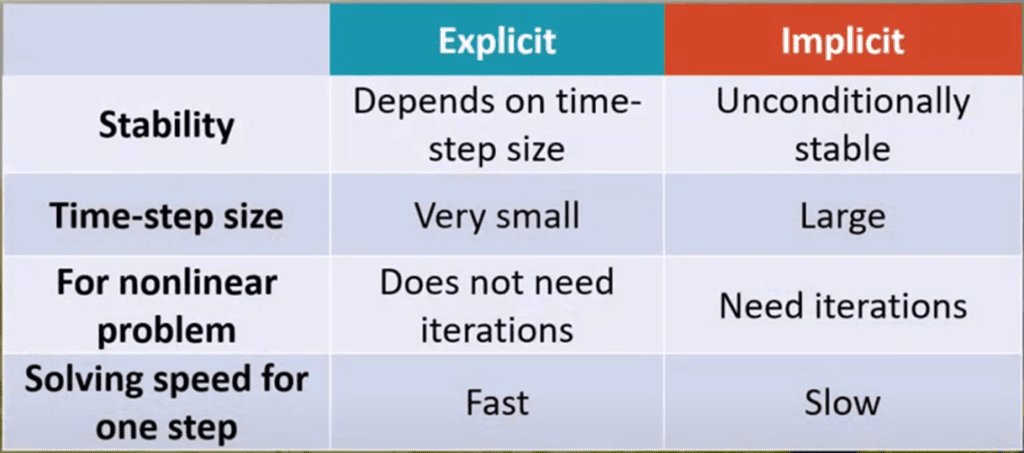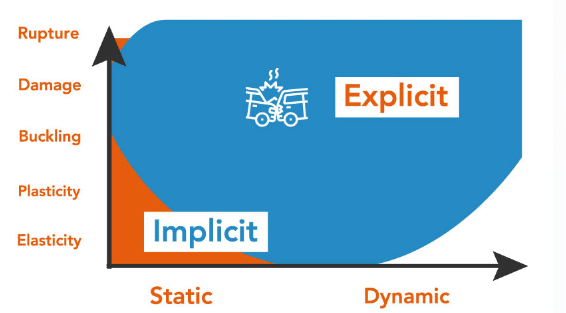ANSYS workbench provides a number of options to perform dynamic analysis in ANSYS. In this article we will view discuss two of these options, the similarities and differences between them, and when to us which one.
Static vs Dynamic Analysis
It is best to clarify the difference between a static and a dynamic analysis before moving on.
In a static analysis the input loads are not a function of time and inertial effects are not considered. The vice versa is true for dynamic analysis.
The general governing equation for dynamic analysis is:
[M]{x´´}(t) + [C]{x´}(t) + [K]{x}(t) = {f}(t)
[M] = Mass Matrix
[C] = Damping Matrix
‘= Time Derivative
[M]{x´´} = Inertia Force
[C]{x´} = Damping Force [K]{x} = Restoring Force
A Static analysis is a simplification of a dynamic analysis where the inertial force (due to acceleration) and damping force (due to velocity) are zero.
Both transient structural and rigid dynamics analysis are dynamic analyses – i.e. they utilize the standard governing equation without any simplifications.
The differences between transient structural and rigid dynamics Analysis
There are two major differences between the two:
- The governing equations are different. See the table below for a comparison between the governing equations for static, transient and rigid dynamics analysis.

As is shown in the table above, rigid body dynamics does not account for the stiffness of the components. This means that stress and strain results are not available with rigid body dynamics.
- Transient structural analysis utilizes the Mechanical APDL Solver which is an Implicit solver. Rigid Dynamics analysis utilized ANSYS Rigid dynamics solver which is an explicit solver. The differences between implicit and explicit solver have been discussed here.
Implicit vs Explicit analysis differ in how they manage time integration in a numerical simulation and are suited for different types of analysis.
Here is a concise table taken from ANSYS rigid body dynamics video summarizing the differences between explicit and implicit analysis.

The table below expands on the comparison between explicit and Implicit Analysis. Transient Structural and rigid body dynamics have been highlighted.
| Entity | Implicit Time Integration | Explicit Time Integration |
| Function Slope Calculation | Implicitly by numerical methods. Calculated at future time step | Explicitly at the current time step |
| Suitable velocity / Strain to be modeled | Relatively much lower | Very high |
| Time increment | Relatively higher | Very low |
| Examples of ANSYS options | Static Structural, Transient Structural | LS-DYNA, AUTODYN, Explicit Dynamics, Rigid dynamics |
| Examples of suitable problems | Static Structural, Transient thermal, Mechanisms | Car Crash, Shockwaves, Ballistics, Blasts |
The plot below is a good graphic summarizing the suit abilities of explicit and implicit solvers:

[Image Credit: Image Credit: https://www.axirogroup.com/show-case/rops-simulation/]
Summary
This final table provides a concise comparison between transient structural and rigid dynamics analysis:
| Item | Transient Structural Analysis | Rigid Dynamics Analysis |
| Governing Equation | [M]{x´´}(t) + [C]{x´}(t) + [K]{x}(t) = {f}(t) | [M]{x´´}(t) + [C]{x´}(t) + = {f}(t) |
| Velocity and acceleration results | Available | Available |
| Stress and strain results | Available | NOT Available |
| Solver type | Implicit | Explicit |
| Suitable for | Flexible bodies, medium to long duration events | Rigid bodies, short duration events |
